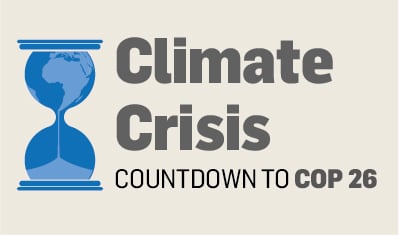Morgan Fagg from Athlone, an English teacher in Madrid, looks back at Cop25, which took place in Madrid in December 2019
The whole world looked to Madrid when Spain offered to host Cop25, in December 2019 at short notice, after civil unrest forced Chile to pull out.

This was the second time that the 25th UN Climate Change Conference Conference, had been forced to change location after the newly elected Brazilian president, Jair Bolsonaro, had withdrawn his country's support.
Spain saved the day, but I don't believe it saved the planet. We were told that 25,000 people would attend the event, but most people were only concerned that a particular Swedish teenager would make it, after Greta Thunberg had sailed halfway across the world, as part of her environmental message that we should listen to the facts and travel less by air. "Listen to the scientists," she would tell Cop25.
Thunberg made it to Spain after sailing from the US to Portugal and taking a train to Madrid. I saw the teenager heavily criticised online but then welcomed by hundreds of thousands when she appeared on stage at a climate-change rally. I saw hundreds of thousands welcome her on stage, but while organisers estimated that 500,000 people attended the event, we could not be sure, as, officially, the Spanish police estimated that only 15,000 people went.
From my limited viewpoint, I would estimate that at least twice as many people were there as at the anti-war protest in Dublin on February 15th, 2003, when an estimated 100,000 people protested against a US-led war in Iraq.
With most people carrying digital devices on their wrists that track our every step, it was incredible, in this digital age with so many social-media posts pinging from the Spanish streets that day, that the police, with helicopters circling the event, could have a figure so far removed from the actuality.
I was delighted Spain had offered to host the event but also a little surprised that Madrid had been chosen, considering the newly elected mayor’s stance against a controversial car zone that restricted the types of vehicles able to drive in the city centre. Madrid had tried to implement a system similar to that in other EU cities, but José Luis Martínez-Almeida’s opposition to Madrid Central, as it is known, helped win him the 2019 election, when the incumbent mayor won more votes than her opponents but not more than the combined vote of conservatives and the ultraright Vox party.
Thanks to the support of the far right, the new mayor immediately halted Madrid Central, and while organisers estimated 60,000 people marched against the mayor in July 2019, police only estimated 10,000. People had marched in the summer heat against the Popular Party’s new mayor, and many of us wore masks on our faces, with one placard ironically saying in Spanish that masks would become the new fashion in 2030.
Ten years earlier than predicted, we were all forced to embrace facemasks in 2020, but thanks to the Popular Party’s unpopularity with environmentalists, I already had masks at home when the pandemic began.
With all eyes on Madrid for Cop25, the city was quick to try and impress the media and the young Swedish teenager sailing across the Atlantic. The mayor launched Madrid Green Capital, which gave the impression that the city had become an EU green capital. It hadn't, but the city did argue that Madrid was a green capital as it had a lot of trees.
Madrid indeed did have a lot of trees, but sadly it lost an estimated 150,000 of them when the weight of heavy snow crushed them last January. I will always remember hearing the distinctive "creek, creek, crack" of trees breaking as I walked through the snow-laden Spanish streets as children enjoyed snowball fights and some of them saw snowmen for the first time.
If you live overseas and would like to share your experience with Irish Times Abroad, email abroad@irishtimes.com with a little information about you and what you do

















